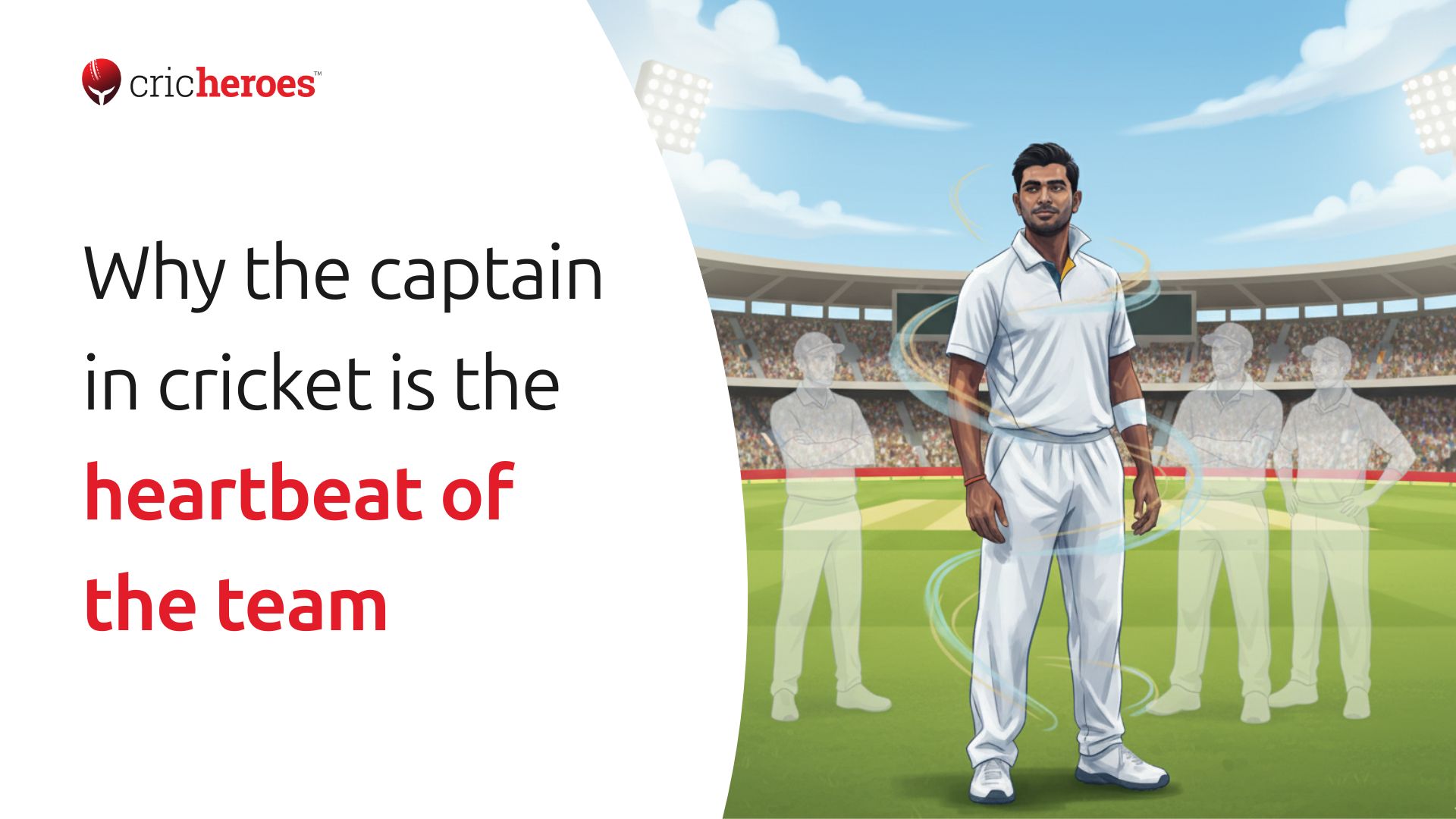Every match begins with a leader who keeps the team steady. Sometimes, it is a World Cup final under lights. Other times, it is a Sunday league match on a dusty local ground. In both cases, the captain sets the tone for how the team plays and behaves.
The captain in cricket is more than a name on the toss card. They guide their team through tactical decisions, emotional moments, and unexpected challenges. When pressure builds, their calm words or simple signals can change the game’s direction.
This blog looks at why every cricket team, from grassroots sides to professional squads, runs on the heart of its captain. It explains how captains lead, decide, and inspire — and why their role matters far beyond the scorecard.
Why the captain’s role in cricket is so unique
Cricket gives its captain more influence than almost any other sport. Each ball brings new choices: where to place a fielder, who should bowl, or when to take a risk. The captain reads every over like a story in motion and keeps the players focused on what comes next.
On the field, captains:
- Set field placements and bowling changes.
- Read pitch conditions and adjust plans quickly.
- Keep communication flowing between bowlers, fielders, and wicketkeepers.
Off the field, they:
- Build trust among teammates.
- Act as the link between players, coaches, and organisers.
- Handle post-match talks and team discipline.
Cricket Q&A
Five quick questions. Get a personal tip.
At the grassroots level, a captain’s role expands even further. They may arrange matches, confirm lineups, talk to scorers, and motivate players who have never played together before. They are both strategist and organiser, keeping cricket enjoyable and fair for everyone involved.
Leadership beyond the boundary: off-field captaincy
The best captains lead even when the game ends. Much of a team’s strength comes from what happens off the field — preparation, team talks, and shared belief.
In grassroots cricket, captains often:
- Organise matches: Handle ground bookings, timing, and player availability.
- Mentor young players: Give advice, share experience, and help newcomers feel welcome.
- Maintain team culture: Encourage discipline, punctuality, and sportsmanship.
- Bridge relationships: Speak to organisers and represent the team fairly.
A good captain also protects the spirit of cricket. They remind players to respect umpires and treat opponents as part of the same cricketing family. Local captains rarely have analysts or support staff, but they still manage their teams with fairness and patience. Their work ensures that every player feels included and that the team grows stronger together.
On-field strategy: how captains shape matches
Every match reflects the captain’s decisions. One smart call can save a collapsing chase or defend a low total. Captains balance instinct with planning to keep the game under control.
Here are some tactical areas where strong leadership makes a difference:
- Field placement: Knowing when to attack with close fielders or protect boundaries.
- Bowling rotation: Pairing pace and spin effectively and managing workloads.
- Batting order: Moving players based on the match situation and opponent strength.
- Decision review system (DRS): Using reviews wisely in professional formats.
For example, MS Dhoni is known for sharp bowling changes at key moments, Brendon McCullum for aggressive tactics that lift team energy, and Kane Williamson for calm strategic thinking in long matches. The same qualities appear at the grassroots level, where a captain’s quick switch or smart batting pair can decide a local tournament.
A captain’s tactical sense is built on observation, experience, and clear communication. When they stay composed and transparent, players trust the plan and give their best for the team.
The human side of captaincy: leading everyday cricketers
Leadership in cricket is not only about plans or statistics. It is about people.
A good captain understands that players have different moods, confidence levels, and motivations. They bring these differences together to create one team spirit.
How captains lead with emotional balance
- Stay calm under pressure: Players copy their captain’s emotions. If the captain remains calm, the team stays focused.
- Listen before guiding: Every player wants to feel heard. Listening builds trust and comfort.
- Encourage after mistakes: A small pat on the back after a dropped catch or a tough over can lift morale.
Balancing personalities in a team
A grassroots captain often manages a mix of friends, new players, and seasoned competitors. Keeping everyone aligned takes empathy and patience. The captain sets the emotional rhythm. When the mood dips, they raise it. When tension grows, they bring calm.
Whether it is Virat Kohli’s fire, Dhoni’s quiet confidence, or a local captain’s thoughtful team huddle, the best leaders turn effort into unity.
Qualities that make a great cricket captain
Every strong cricket captain shares a few core traits. These qualities build trust, improve performance, and keep the team motivated, no matter the level of play.
1. Calm under pressure
Games often test nerves more than skills. A calm captain helps players make clear choices when the match feels tight.
2.Sharp cricket awareness
Good captains read the pitch, weather, and opposition before others notice. They anticipate situations rather than react to them.
3. Clear communication
Messages must reach every player quickly and simply. Confusion wastes time and effort, especially during close contests.
4. Leading by example
Captains who train hard, arrive early, and play fair set the standard for others to follow. Actions carry more weight than speeches.
5. Fairness and inclusion
At the grassroots level, this is essential. Rotating the batting order, giving everyone a bowl, and supporting younger players builds long-term loyalty.
6. Empathy
Understanding a player’s mindset can change how they perform. A few kind words at the right moment can make a difference.
Great captains, from MS Dhoni to local league leaders, share these habits. They are steady under stress and human in every action.
Building team culture from the ground up
A team’s culture defines how it plays, reacts, and grows. The captain is the foundation of that culture.
At the grassroots level, where players often juggle cricket with jobs or studies, the captain’s approach shapes commitment and spirit.
How captains build strong team culture
- Set shared goals: A captain who includes everyone in setting targets ensures players feel part of the mission.
- Encourage teamwork: Recognise efforts like a smart run-out or tight over, not just centuries or wickets.
- Create simple traditions: Pre-match huddles, post-match group photos, or small awards keep the team bonded.
- Uphold respect: Treat opponents and umpires with courtesy to model sportsmanship.
When captains celebrate small wins and shared effort, players stay connected. They play for each other, not just for the scoreboard. This spirit turns a team into a community — the essence of CricHeroes’ message, Your cricket matters.
Leadership styles across levels: from local grounds to legends
Not every captain leads the same way.
Some shout to motivate, while others lead quietly through trust. The key is understanding what the team responds to.
Common leadership styles in cricket
- The motivator: Full of energy, builds confidence through enthusiasm. Example: Imran Khan inspiring his 1992 World Cup team.
- The strategist: Focuses on tactics and game awareness. Example: Dhoni adjusting plans mid-match without drama.
- The mentor: Guides younger or less experienced players, like Kane Williamson helping new teammates settle in.
- The performer: Leads through personal excellence, such as Kohli’s commitment to fitness and performance.
At the grassroots level, these styles often mix. One day, a captain needs to motivate; the next, they must strategise or mentor. What matters most is self-awareness — knowing when to speak, when to act, and when to simply lead by example.
Challenges captains face in modern and grassroots cricket
Every captain faces moments that test more than skill. Leadership brings pressure, expectations, and constant decisions. The difference between a good and great captain often lies in how they handle these moments.
Common challenges captains deal with
- Balancing form and leadership: Captains must manage their own performance while guiding others. A bad spell or poor score can affect confidence, but staying composed helps the team stay steady.
- Managing personalities: Teams mix experienced and new players. Some are calm, others expressive. Keeping harmony takes patience and fairness.
- Handling public and peer pressure: From social media comments to locker room debates, criticism is part of the job. A grounded captain listens, learns, and moves on.
- Limited resources at local level: Grassroots captains manage without analysts, substitutes, or staff. They plan practice, set fields, and handle logistics, often after work or school.
- Mental fatigue: Every decision carries weight. Smart captains take small breaks, delegate tasks, and keep cricket enjoyable for everyone.
Captains who meet these challenges with calm and clarity strengthen not only their teams but also themselves. Leadership grows through experience, not ease.
The captain-coach relationship: shared leadership on and off the field
Strong teams are built on trust between the captain and coach. Both guide strategy, player growth, and morale, but in different ways.
- The coach plans long-term goals, training, and player development.
- The captain manages match-day execution, field decisions, and team spirit.
When they work together, teams perform with purpose. Successful examples include:
- MS Dhoni and Gary Kirsten building India’s calm, confident unit between 2008–2011.
- Ricky Ponting and John Buchanan led Australia through their dominant Test and ODI years.
- Eoin Morgan and Trevor Bayliss turned England’s white-ball side into a global champion team.
In grassroots cricket, the captain often fills both roles. They organise practice, help teammates fix technique, and motivate them to improve. Shared leadership means knowing when to listen and when to guide. When that balance exists, the team grows stronger every match.
Measuring success: what makes a great captain
Winning is one measure of leadership, but it is not the only one.
A great captain leaves behind respect, trust, and a sense of togetherness that lasts long after the match ends.
Ways to measure captaincy success
1. Team Growth:
Has the team improved over time? Are players more confident and skilled than before?
2. Player Retention:
Do players return season after season because they enjoy playing together?
3. Match Awareness:
Does the captain read games well and make timely decisions?
4. Team Morale:
Is the dressing room positive and supportive, even after losses?
5. Performance Consistency:
Are results steady over months or tournaments, not just one lucky win?
In grassroots cricket, captains can track success with data too. Platforms like CricHeroes allow leaders to measure win percentages, partnerships, and player contributions over time. These numbers, combined with trust and respect, reveal true leadership.
A good captain does not chase personal fame. They chase team balance and unity — because when the team plays as one, every player shines.
Modern and future leadership in cricket
Cricket captaincy keeps changing with the game. New formats, data tools, and tournament structures now shape how leaders think and act. Yet one truth remains — leadership still depends on trust, teamwork, and courage.
Key trends in modern captaincy
- Split-format leadership: Many teams now have different captains for Tests, ODIs, and T20s. This helps share pressure and allows captains to focus on specific formats.
- Use of data and analytics: Captains now access match insights and player stats in real time. Even grassroots leaders use score tracking and match analysis on platforms like CricHeroes to plan better.
- Women’s and youth captaincy growth: More women and young players now lead their teams with skill and confidence. Their rise shows that leadership is about mindset, not age or gender.
- Franchise and local tournaments: League formats such as IPL or regional competitions demand captains who can handle quick decisions, new teammates, and high expectations.
- Mental health awareness: Modern captains focus on emotional balance as much as tactics. A positive, caring environment keeps the team steady and united.
The future of captaincy will combine technology and empathy. Data may guide choices, but the captain’s heart will always keep the team together.
Stories of leadership: from local grounds to global glory
Every captain’s journey begins somewhere. Some start in school tournaments, others in community matches or backyard cricket. These experiences build the foundation of leadership that later shapes national or international teams.
Grassroots to greatness: real examples
- MS Dhoni: From leading local clubs in Ranchi to guiding India to world titles, Dhoni showed that calm decisions and people-first thinking work at every level.
- Imran Khan: Inspired young cricketers by leading with self-belief and unity. His 1992 World Cup win proved leadership is as much about belief as strategy.
- Local heroes on CricHeroes: Every week, captains in local tournaments organise teams, motivate players, and handle pressure with the same spirit as the pros. Their stories remind us that leadership begins with effort, not fame.
Good captaincy looks the same on every pitch — caring for teammates, making fair calls, and putting the team ahead of self. Whether it is a global icon or a local leader, the message is simple: when the captain believes, the team grows.
Lessons for aspiring captains
Anyone can become a better captain with practice and reflection. Leadership is learned through action, not theory.
Practical tips for new and aspiring captains
- Observe and learn: Watch how top captains react during tense moments. Notice how they stay calm and plan ahead.
- Stay honest and fair: Team trust depends on honesty. Give feedback respectfully and make fair decisions.
- Communicate clearly: Short, simple messages reach everyone faster. Avoid confusion with mixed instructions.
- Lead by example: Arrive early, respect all players, and show discipline. Actions speak louder than advice.
- Use match data wisely: Track stats on apps like CricHeroes to measure team growth and plan better.
- Focus on the team’s joy: Celebrate small wins, appreciate effort, and make cricket enjoyable.
Great leadership is not about being the loudest voice. It is about being the steady one that others trust when things get tough. The best captains make everyone feel part of the game — that their cricket matters.
Conclusion
Every cricket team, from international sides to gully squads, depends on one person who ties it all together — the captain. Their choices set the tempo, their calm keeps confidence alive, and their belief fuels the team’s heart.
A great captain is not judged only by trophies. They are remembered for fairness, teamwork, and courage during tough times.
They make players better by trusting them, and they make matches better by guiding them.
Cricket has changed with time, but one truth remains: when the captain leads with heart, the team follows with belief.
Closing thought
Whether you captain a school team, a city club, or a weekend side, remember this — your cricket matters. Every score, every plan, every word of encouragement shapes the game.
If you are ready to lead your team, start tracking your matches, stats, and stories on CricHeroes, the home of grassroots cricket.
Your story deserves to be scored. Start your match today on CricHeroes.
Faq
1. Why is the captain called the heartbeat of the team?
Because the captain connects everyone. Their decisions, emotions, and actions influence the entire team’s rhythm and confidence.
2. What is the role of a captain in a cricket team?
A captain manages tactics, motivates players, maintains discipline, and represents the team on and off the field.
3. Can a bowler or wicketkeeper be a captain?
Yes. Many teams have had bowlers and wicketkeepers as captains. Leadership depends on awareness, not batting position.
4. How does a captain keep morale high after losses?
By staying calm, talking openly, and highlighting effort instead of mistakes. Players respond best when they feel supported.
5. What makes a good cricket captain?
A mix of tactical sense, empathy, fairness, and composure. Good captains listen, plan, and guide without ego.
6. How do grassroots captains manage teams without staff?
They handle logistics, lineups, and motivation themselves. Apps like CricHeroes help by tracking scores and stats easily.
7. How are captains selected?
Usually by team consensus or management choice, based on leadership qualities and consistent performance.
8. How does captaincy affect personal performance?
It can be challenging, but captains who stay organised and calm often perform better due to focus and responsibility.
9. What are the biggest challenges of being a cricket captain?
Balancing personal form, decision-making, and team harmony. Each day tests leadership in a new way.
10. Can leadership be learned or is it natural?
Leadership can be learned. Every captain improves with time, feedback, and consistent effort.

I am Manan Joshi , SEO All-Rounder at CricHeroes.
CricHeroes is the ultimate Cricket Scoring App and the world’s only true Cricket Network. With more than 4 crore+ registered cricketers using CricHeroes to Live Cricket Scores for their local cricket matches and tournaments, CricHeroes is already the #1 Cricket Scoring App Globally!
We also proudly present “CricHeroes Store” by CricHeroes, a dedicated shop for cricket apparel and accessories, helping players gear up for their game.















